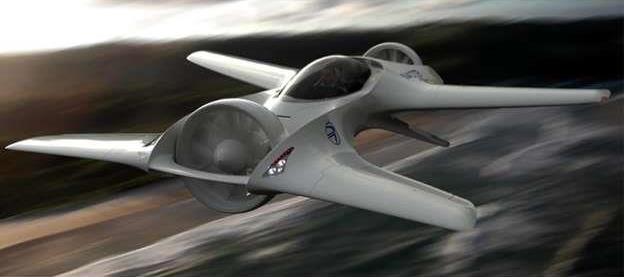
Engineered for maximum efficiency, the DR-7 is built like a formula one race car... for the sky. With its monocoque composite construction, Ultra low drag body, and tandem seating configuration, weight is kept to a minimum for unrivaled performance and range.
The DeLorean Aerospace DR-7 would be a twin forward and rear tilt propeller flying car developed for personal use.
The forward and rear propellers will be capable of 360 degree forward/back tilt. In vertical mode the DeLorean will be able to achieve Vertical Take-Off and Landing (VTOL). As the propellers tilt more toward a horizontal position it will enter cruising mode. The front system is a tractor propeller and the rear prop a pusher. The counter-spinning fans will help stabilize the DR-7 as well as provide roll and yaw control while hovering and yaw while in cruising flight. The thrust-vectoring system precludes the need of a rudder. The fuselage will act as an airfoil with stall-resistant canard. The design will increase efficiency and decrease stall resistance to low speeds. The DR-7 will have a cruising speed of 241 km/h with a top speed of 389 km/h. At full speed the range will be 193 km.
The DR-7 will carry two passengers in a tandem configuration. It will be 6 m long with a wingspan of 5.6 m. The wings will fold the vehicle to a 2.3 m width allowing it to fit in a garage.
DeLorean intends for the vehicle to be a high end flying car for commuting and personal travel. Costs are expected to be in the $250,000-300,000 range.
A 1/3 scale proof-of-concept composite aircraft has been tested successfully. There is no hard timeline for additional tests and the company is currently seeking investors for a full-sized prototype.
DeLorean Aerospace was founded in 2012 by Paul DeLorean, the nephew of famous car designer John DeLorean.
DeLorean unveils DR-7 VTOL
11 Jun 2017
On June 8, 2017, Paul DeLorean, CEO and chief designer at DeLorean Aerospace, unveiled a concept video and illustrations of the two-seat DR-7 electric VTOL.
According to DeLorean, the DR-7 is designed to be a personal commuter aircraft that would have a much broader market appeal than conventional planes and helicopters, due to its high-speed efficiency, VTOL function and autonomous control system. “With a compact footprint and minimized proximity hazard of enclosed rotors, it is a viable option for close-quarters launches and landings.”
Before the DR-7, there were six variants of the same basic configuration, including the simulation model, sub-scale proof of concept demonstrators, etc. DeLorean Aerospace was founded specifically to develop and produce this and other aircraft concepts.
The DR-7 is not a so-called “flying car,” but rather a VTOL-capable airplane, with conventional control surfaces and a push/pull propulsion system (a tractor front fan and a pusher rear fan). The centerline-twin-vectoring configuration (CTV) has proven to be extremely stable. Basically, the pressure centers of the rotors sit above the center of mass of the craft, mimicking the two-point suspension of a hammock. The gyroscopic effect of the counter-rotating rotors further stabilizes, while providing a positive dampening effect.
The vehicle uses a unique and robust gimbal system to direct thrust in 360 degrees, providing roll and yaw control while hovering, and yaw in forward flight, eliminating the need for a conventional rudder and the associated drag. After experimenting with vanes, it became obvious to DeLorean that launches from uneven surfaces were unpredictable and dangerous, in addition to mention the drag penalty. The vectoring input also remains consistent from hover to forward flight, so control mixing is not needed, as it would be with lateral propulsion designs (i.e., roll is always roll and yaw is always yaw).
In airplane mode, the also fan efflux over the fuselage creates additional lift, aiding stall resistance and allowing a smaller wing area. Conventional launches and landings are possible in event of power failure or other emergency conditions.
DeLorean stated in June 2017, “We recently finished our proof-of-concept testing and engineering hand-off model (bootstrapped and angel funded) and have just begun to seek funding for the piloted prototype. We are in discussion now with a few established manufacturers to build this prototype and anticipate its construction within a year.”
The aircraft is 20 ft (6.1 m) in length and wingspan. Folded width is 7.5 ft (2.3 m). Based on power studies and simulator data, DeLorean expects a top speed of about 240 mph (210 kt or 385 km/h), but with a variable pitch option bringing that to 300 mph (260 kt or 480 km/h) or more. Efficient cruise would be in the 150 mph (130 kt or 240 km/h) range.
The price is predicted to “likely fall between $250-300k” for the fixed-pitch variant.
A free template by Lucknowwebs.com for WYSIWYG WebBuilder 8
Nigel G Wilcox
Paragon Of Space Publication
© Copyright Reserved - United Kingdom
Ideal Screen Composition 1024 x 768
Best Flying Cars Around the World
© 2019 DeLorean Aerospace
DeLorean DR-7
The DeLorean DR-7 is the brainchild of Paul DeLorean, nephew of John who famously created the iconic DMC-12. Paul now owns and runs DeLorean Aerospace and the DR-7 is its first project. The DR-7 has completed its proof-of-concept testing and is currently seeking funding to carry out a manned test flight. It's hoping to be operational from the end of 2018 and if and when it eventually goes on sale, it's expected to fetch between $250,000-$300,000
Max Speed: 300mph in the air
Engine: Pair of 360-degree thrust-vectoring electric ducted fans
Range: 120 miles
Courtesy: pocket-lint.com
DR-7
DeLorean Aerospace
Laguna Beach, California, USA
www.deloreanaerospace.com
/evtol.news/2017/06/11/delorean-unveils-dr-7-evtol
SITEMAP
SCIENCE RESEARCH
ABOUT
Desk
MAIN INDEX
Flying Cars
S'sonic
Stealth
Menu
Space
Transport
Menu
Topic
Menu
P2
P1
Study
Menu


